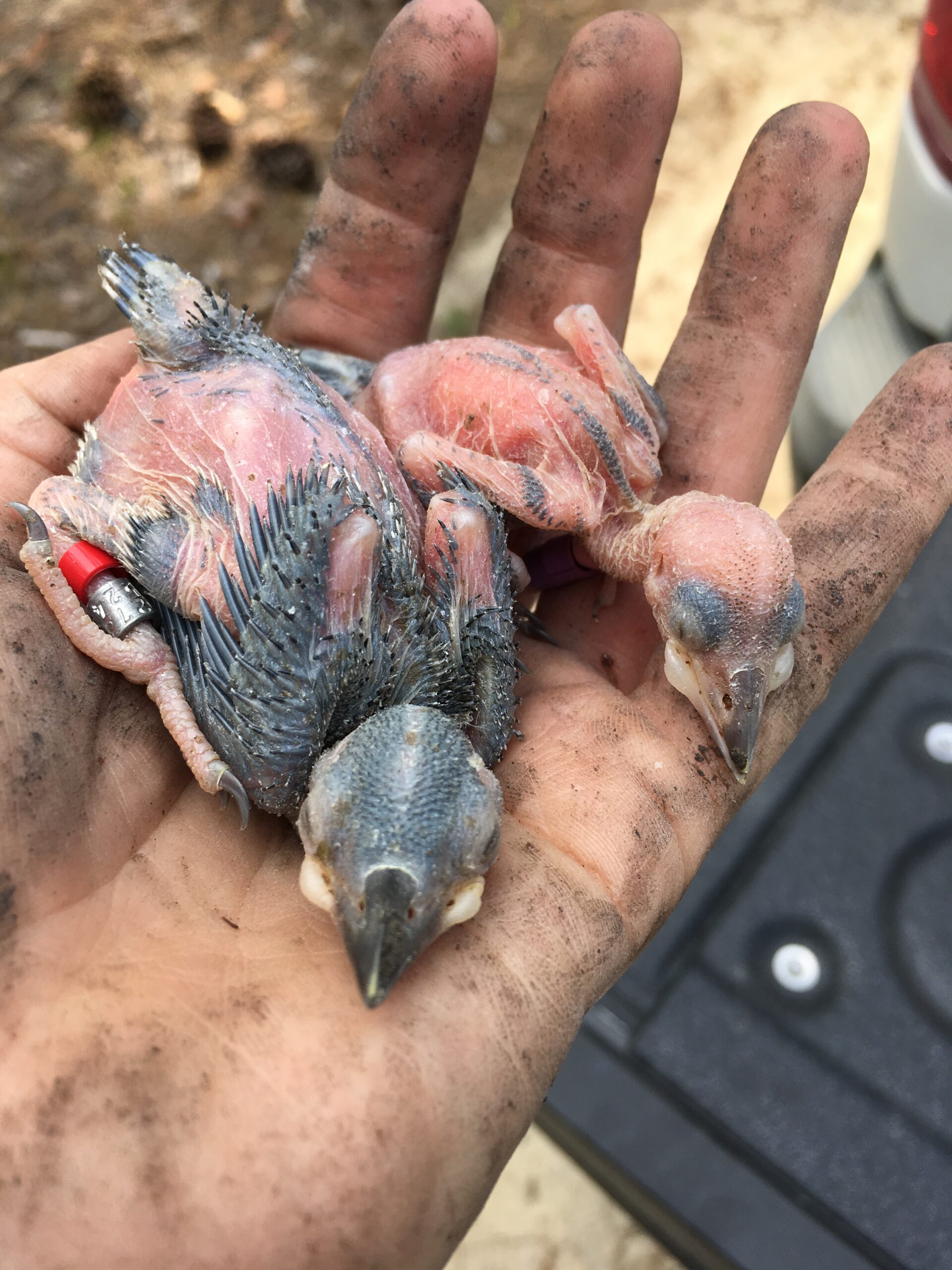Spring in the Pines: Breeding Season for the Red-Cockaded Woodpecker

Even the most ardent tree-lovers among us may be feeling less kindly about our Carolina pines during these weeks when pollen drifts down from above like fluorescent yellow snow. Despite the allergies and annoyances that accompany the season, spring is also a time to celebrate that our trees are more than just pollen producers, they’re also nurseries for an imperiled species whose survival depends on our precious pines.
This month, let’s peer into the chiseled chambers where our Red-Cockaded Woodpeckers raise their next generation, and explore their remarkable breeding habits.
For those of us gleefully watching our familiar backyard birds raise their broods this time of year, the basic rhythms of breeding season can feel more or less predictable: mate pairing, nest building, egg laying, chick rearing. But the Red-Cockaded Woodpecker’s complex community complicates that basic story in fascinating ways. RCWs live in highly cooperative, social family groups usually consisting of a breeding pair and up to four immature males (one to three years old) who are almost always offspring from previous seasons.
Unfortunately, there is scant literature on mate selection and courtship in RCWs. But the University of Michigan Museum of Zoology offers:
“Red-cockaded woodpeckers are a monogamous species. They have one mate and a ‘courting’ process that lasts up to a year…To attract their mates, males have many ways of communicating with females. In the spring, males can tap on wood for short-distance communication…[M]ales can use a series of calls such as ‘szreks’, ‘wing whulls’, and ‘chits’ as forms of communication. One of the most common ways for males to attract a mate is by participating in a flutter aerial display, a process in which males chase each other around trees, with their wings open until the point of exhaustion. Female participation in aerial displays has not been noted.”
RCWs do not build a traditional nest. The cavities they carve into living pines serve a dual purpose: providing a nest site for breeding each year and offering family members their own roosting place each night for protection from predators and the elements. Eggs are laid in the cavity of the breeding male which usually has a lining of wood chips left over from excavation, but no additional nest is built inside. As long as the cavity remains intact, dry, and free of predators or parasites, it will be maintained, defended, and reused each year, potentially for decades.
Females lay a clutch of two to five eggs, and like many birds who lay their eggs in well-hidden cavities, RCW eggs are not camouflaged and are a solid, glossy white, about an inch long. The incubation period is a brief ten to 12 days, but the nestling period can last as long as 29 days before fledging. Chicks are altricial, meaning they hatch with closed eyes, little or no down feathers, and are completely dependent on parents for warmth, protection, and food. RCWs usually produce only one successful nest per year, though they may attempt to re-nest if a clutch or brood is lost, but a second successful brood is very rare.
The entire family assists with all tasks, with both the male and female along with the male helpers incubating the eggs, feeding nestlings, and defending the cavity. Like their adult relatives, nestlings mostly eat a delicious melange of ants, beetle larvae, wood roaches, spiders, caterpillars, and other insects. These prey items are found by gleaning and pecking on live pine trees as RCWs specialize in flaking off bark and probing crevices where insects are tucked away. Young are fed by both parents and helpers for up to six months after fledging, a relatively long period which underscores the unique cooperative breeding behavior of RCWs.
So as we rinse the yellow haze from our porches and breathe a little easier beneath the pine canopy, let’s celebrate our woodpeckers, and all of their feathered brethren, who are hard at work tending to their young. In next month’s post, we’ll take a closer look at the ecological and behavioral forces that shape the Red-Cockaded Woodpecker’s complex family structure, and consider how life within cooperative groups helps the species endure.
Additional photos and videos:
RCW fledglings leaving the nest
Blog post written by WAS Volunteer, Brittany Richards
Main photo credit: Nestling, photo by Gabriela Garrison, North Carolina Wildlife Resources Commission


